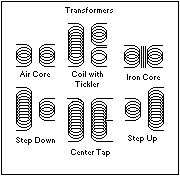Types of Transformer windings:
Transformer windings transform electrical power of one voltage to another voltage in this way they act as the heart of the transformer.
Depending upon the power rating and application of the transformer different types of windings are employed.
1) Helical windings
2) Cross over
3) Sandwich windings
Helical windings:
One of the most commonly used winding methods is the helical type helical windings are shaped into a helix and are usually used in low voltage windings but as the current to be handled becomes larger the complexity of such windings increases a large current requires a large cross-sectional area thus eddy current the loss also becomes high for this reason two or more conductors connected in parallel have to be used to reduce eddy current loss the modern practice is to use a continuously transposed cable.
Cross over:
Cross over windings are employed for high voltage applications where a series of blocks are formed by winding circular conductors in different layers and turns disc type windings are used in transformers with a high power rating here disks are made from spiraling conductors at the same place such as alternating disks are connected in series using inner and outer crossovers.

Sandwich windings:
Sandwich windings use a unique configuration where high voltage and low voltage windings sit in the same magnetic access and each high voltage unit lies between two low-voltage units thus the leakage flux is greatly reduced.

That's all about the transformer windings.


